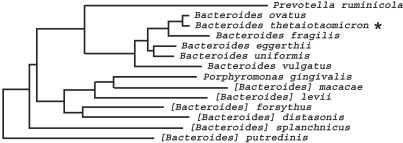Fig. 2.
Phylogeny of Bacteroides and related species. Members of the Bacteroidales order are common inhabitants of the mammalian digestive tract. The order includes four established families: Bacteroidaceae, Porphyromonadaceae, Prevotellaceae, and Rikenellaceae. Porphyromonas gingivalis (Porphyromonadaceae family) is associated with periodontal disease of humans. Its genome has been sequenced (www.tigr.org/tdb/mdb/mdbinprogress.html). Bacteroides forsythus, now renamed Tannerella forsythensis (Porphyromonadaceae family), is a human dental pathogen that has been partially sequenced (198 contigs, ≈3.6 Mb, unpublished work; www.tigr.org/tdb/mdb/mdbinprogress.html). Prevotella ruminicola (Prevotellaceae family) is a prominent member of the rumen and plays a central role in ruminal digestion of feed proteins. Brackets denote that for these species, initial assignment to this genus was based on biochemical phenotype: their 16S rDNA sequences indicate that their membership in Bacteroides should be viewed as tentative (adapted from ref. 82).

